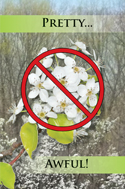
BMP's
Best Management Practices
The "Top Ten" List
1. Develop an organizational Invasive Species Stategy:
- Goals
- Objectives and Priorities
- Tactics - Policies and Procedures on:
- Employee education & training
- User education
- Contracting & sourcing
- Monitoring
- Prevention
- Control projects
- Schedule regular assessments - Measure and celebrate your success!
2. Create and maintain an IS knowledge base:
- Maps - Where are current infestations
- Reporting & mapping process for staff and users
- Documentation of control projects - exact location, treatment protocol, dates, herbicide concentrations, weather and soil conditions, etc. - and assessment of results initially and after additional growing seasons
3. Think ahead. Pre-plan major land development or maintenance activities:
- Avoid disturbing heavily infested areas when possible
- Pre-treat areas that must be disturbed well in advance
- If possible, conduct such activities when seeds are not easily movable
- If possible use existing roads, trails, landings, staging areas, and designated equipment cleaning areas
4. Use native plants and seeds - and make sure they are from "weed-free" sources:
- Use species that are appropriate to site and conditions
- Assure that species received are as specified
- Assure that new plants and seeds are not contaminated
- Use "trusted sources" whenever possible Indiana Native Plant and Wildflower Society Sources of Native Indiana Plants list
- Ask for guarantees or make-good provisions in sourcing contracts
5. Use uncontaminated construction/landscaping material (mulch, fill, gravel, straw, etc.):
- Find certified or guaranteed sources when possible Indiana Certified Weed Free Program
- Use trusted sources whenever possible
- Ask for guarantees or make-good provisions in sourcing contracts
- Look to create on site sources if possible
- Monitor stock piles regularly
6. Keep tools, equipment, vehicles and clothing clean:
- Require contractors to bring clean vehicles and equipment to your site
- Designate contained areas for cleaning and disposal
- Educate and encourage users to inspect and clean clothing, equipment, pets, etc. before and after entry
7. Have a long-term plan for managing Invasives:
- "An ounce of prevention..."
- Prioritize locations and species - taking into account severity of infestation, degree of invasiveness, feasibility of control, "value" of habitat at risk, etc.
- "Optimize" treatment timing and technique
- Evaluate, measure, and document success
8. Monitor disturbed locations and high risk areas:
- Monitor regularly and frequently
- Especially important following natural disasters and major development or maintenance projects
9. Require contractors to follow BMPs:
- Incorporate BMP requirements into RFPs and contracts
- Inspect and document infestations before and after contractor activity
- Ask for guarantees or make-good provisions
10. Educate recreational users (and neighbors) on Invasive Species BMPs:
- Provide basic education when possible:
- What are invasive species?
- Why are they bad?
- How to identify key species
- Offer a mechanism for reporting invasives
- Provide cleaning stations at key entry and exit points
- Regulate entry of infested material when possible (campfire wood, hay, bait, etc.)
And one to grow on: Actively look for funding opportunities, partnerships, and volunteers to assist in preventing and reducing invasive species!
Download a PDF

